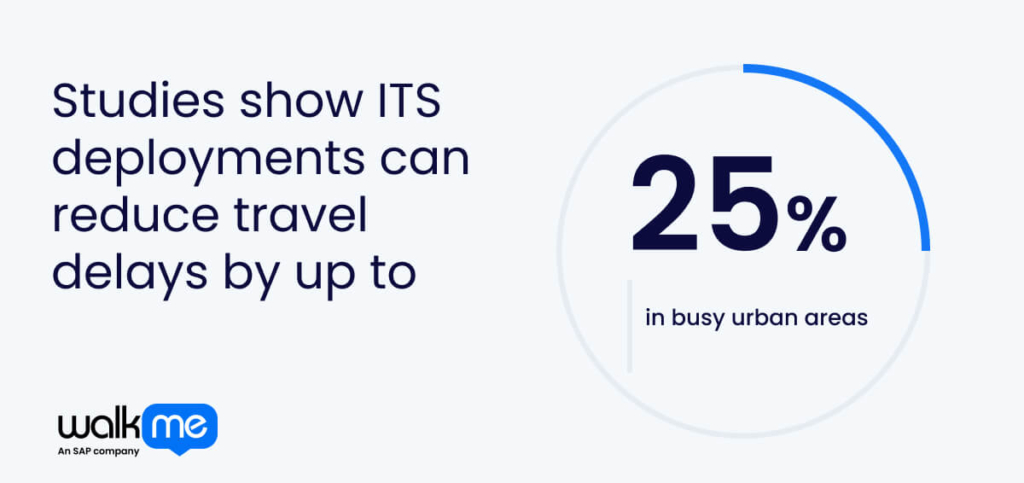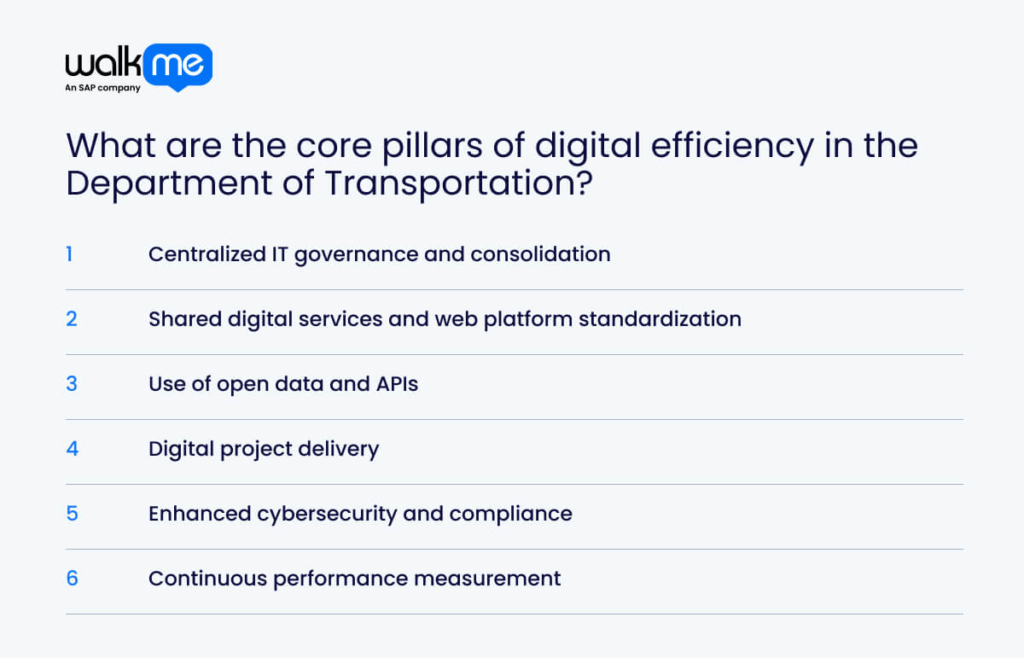Digital efficiency is changing how the Department of Transportation (DoT) keeps America connected.
The U.S. transportation system is vast, encompassing airports, highways, railways, and ports. It has also expanded significantly over the past few decades.
To meet rising demand, the DoT is turning to digital infrastructure that makes networks smarter, faster, and more dependable. This includes using new technology, better data systems, and modern infrastructure planning.
The department is investing heavily to maintain a strong, flexible, and adaptable transportation system. Placing digital innovation at the heart of its strategy, the DoT is shaping the future of America’s mobility.
This article explores how the DoT uses digital efficiency, through technology, governance, and data, to upgrade systems and prepare infrastructure for the future.
What is digital efficiency in the Department of Transportation?
Digital efficiency at the U.S. Department of Transportation (DoT) means using advanced technology and data to improve how transportation networks operate.
It focuses on reducing delays, lowering costs, and enhancing safety across highways, railways, airports, and ports. For example, the Intelligent Transportation Systems (ITS) program uses sensors and real-time data to manage traffic flow, cutting congestion and travel times.
Studies show ITS deployments can reduce travel delays by up to 25% in busy urban areas.

Efficiency contributors such as intelligent automation drive a more responsive and sustainable transportation system. In this regard, it represents a shift from outdated systems to more innovative infrastructure that can adapt as demands grow and cities evolve.
Why is digital efficiency in the Department of Transportation important?
Digital efficiency helps the Department of Transportation manage many parts of America’s travel network, from roads and bridges to airports and railways.
Citizens rely on these systems, making it essential to keep them safe, dependable, and efficient. For example, smart sensors monitor bridge conditions in real-time, alerting engineers to damage before it becomes hazardous.
According to the DOT, these sensors can reduce inspection costs by up to 40% and prevent costly repairs. That kind of saving adds up quickly when applied across thousands of bridges, tunnels, and transit systems nationwide.
Digital efficiency is a clear example of how targeted technology use can shift public infrastructure from reactive to proactive.
What are the core pillars of digital efficiency in the Department of Transportation?

We’ve now covered what digital efficiency means at the Department of Transportation and why it matters, along with a brief look at the Federal Highway Administration (FHWA).
Next, we’ll explore the core pillars of digital efficiency at the DoT. These pillars represent the primary areas the department will focus on in the coming years. Understanding them is the next step on the path toward building a more resilient transportation system.
Let’s take a closer look at the core pillars of digital efficiency in the DoT:
Centralized IT governance and consolidation
The Department of Transportation uses centralized governance to unify IT budgets and decision-making, reducing duplicate systems. Tools like the Integrated Digital Infrastructure (IDI) platform help manage data in one place, making sure all agencies follow the same security and compliance standards. This focus saves resources, reduces overlap, and speeds up technology upgrades across the transportation network.
Shared digital services and web platform standardization
Through the Digital.gov platform, the DoT is creating a consistent experience for users and a unified backend for its websites and apps. Sharing reusable parts and APIs also speeds up deployments. Having consistent platforms makes services easier to access and simplifies maintenance across the DoT’s many digital tools.
Use of open data and APIs
The DoT’s open data portal and APIs share real-time information about transit, traffic, and infrastructure. Standard APIs allow developers to build tools like the National Transit Database apps, improving mobility and transparency. This openness encourages new ideas and partnerships that make the system more responsive.
Digital project delivery
The DoT uses Building Information Modeling (BIM) and Geographic Information Systems (GIS) to track project progress digitally. These tools offer clear visuals and data forecasts, helping reduce cost overruns. Digital workflows replace paper processes, increasing accuracy and allowing teams to spot risks early.
Enhanced cybersecurity and compliance
Tools like Security Information and Event Management (SIEM) systems are used to continuously monitor threats. Following NIST standards protects data across key infrastructure. This layered cybersecurity approach defends systems against evolving attacks, keeping data and operations safe.
Continuous performance measurement
Using dashboards from the Performance.gov platform, the DoT tracks key indicators like traffic flow and asset health in real-time. Machine learning (ML) models identify trends, using predictive analytics to guide maintenance planning and allocate resources more effectively. Ongoing reviews support flexible strategies to meet changing transportation needs effectively.
What are some examples of DoT digital efficiency in action?
At this point in the journey, it’s worth examining some examples of digital efficiency to give you a clear picture of how these innovations are making a measurable difference across America’s transportation network.
It’s also worth mentioning that these projects demonstrate how the Department of Transportation is leveraging data to create smarter, safer, and more reliable travel experiences for everyone.
Let’s take a closer look at some examples of digital efficiency at the DoT:
Transportation.gov enterprise web platform consolidation
The DoT shifted from running dozens of separate websites to using one shared platform, following the 21st Century IDEA mandate. Now, sites like transportation.gov, highways.dot.gov, and nhtsa.gov run on the same open-source system.
This change made the brand more consistent, lowered hosting costs, and sped up updates. The Office of the CIO manages the platform, improving security and performance. With everything in one place, it’s easier to add new features and provide users with a simple and reliable online experience.
Digital Delivery Program at PennDOT
Pennsylvania’s Department of Transportation is testing a digital-first project delivery system to manage infrastructure projects. It uses BIM and GIS to let teams see detailed project plans before construction begins.
Everyone works from a single portal, checking progress, tracking goals, and planning resources in real-time. This setup breaks down data silos, improves coordination between regions, and keeps projects on track. The result is faster, better-planned road and bridge repairs.
IT personnel consolidation by the CIO’s office
After launching the COMMON Operating Environment, the DoT’s CIO office brought IT staff and services together under one system. Instead of each agency having its own team, one digital workspace now handles desktops, networks, servers, and cybersecurity.
This reduced contract overlap, made hiring easier, and helped teams share knowledge across departments. With connected tools and clear processes, support issues are resolved faster, and security risks decrease due to improved patching and monitoring.
SaferCar.gov
The NHTSA’s SaferCar app helps drivers stay informed about vehicle safety. It includes tools like VIN scanning, crash ratings, and child-seat guides. Millions of users rely on it to check if their cars need safety fixes.
Real-time APIs enable developers to add this safety data to other apps and services. Unsafe cars are flagged quickly, and drivers receive the necessary updates. These tools also give people control over their safety while enabling regulators to respond more rapidly.
How does the Department of Transportation enable digital efficiency through IT governance?
The Department of Transportation is bringing its IT systems under one roof to create a clear, shared approach across all its agencies.
The Chief Information Officer’s office leads this effort by setting policies that reduce unnecessary software and hardware.
Consolidating data centers and cloud ecosystems enables the department to save money and enhance system reliability. Instead of each agency running its own network, shared systems allow faster updates and steady security across the board.
Programs like FedRAMP help guide compliance and lower security risks. A single setup also speeds up disaster response with clear communication and fast system access.
Strategic consolidation means fewer disconnected systems, less wasted budget, and a stronger defense against cyber threats.
The department’s governance approach creates a foundation for scaling new technologies while keeping controls tight. This is essential given the vast scope of transportation assets it manages nationwide.
What’s next for digital efficiency in the Department of Transportation?
The Department of Transportation (DoT) may not always get the spotlight, but it plays a central role in shaping America’s future.
Building roads, bridges, and other infrastructure depends on every part of the department working with robust digital systems.
To keep the U.S. competitive and digitally resilient, its infrastructure and transport networks must be built to stand the test of time.
Digital efficiency in this regard helps the DoT ensure that infrastructure investments yield long-term benefits. The department’s work today shapes the experience of travel and commerce for generations who will rely on these systems in the future.
FAQs
Digital as-builts offer accurate, current maps and records of highway infrastructure. They help crews find problems faster, plan repairs more clearly, and avoid errors that lead to extra costs. That means less downtime and lower overall maintenance spending.
PennDOT uses cloud-based tools, real-time data sharing, and automated workflows to keep teams connected. These tools improve communication, cut delays, and help projects stay on track and within budget.
Shared services consolidate common tasks under a single system, reducing duplication and saving money. API standards let different systems work together, making it easier to access data and run digital tools across the department.

